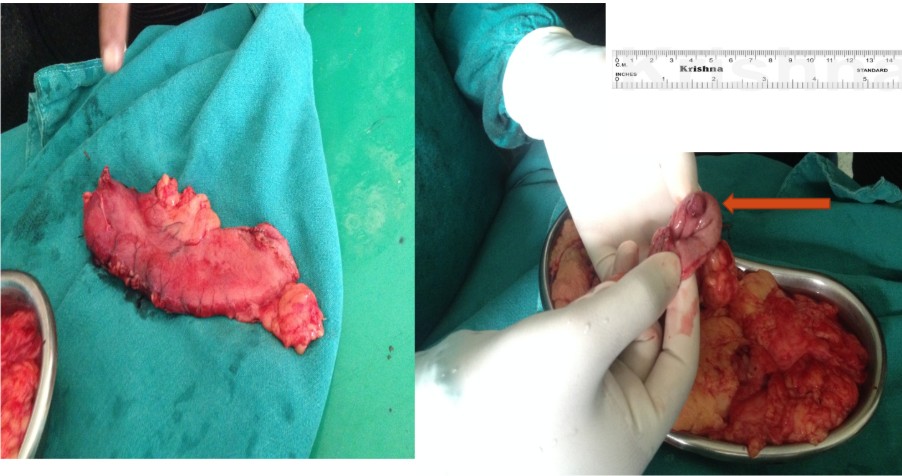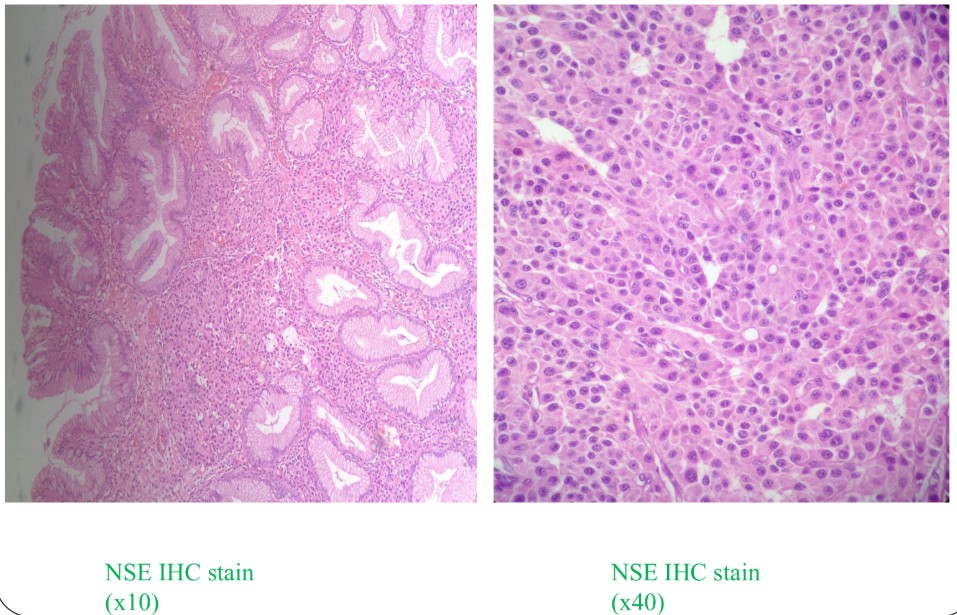Tuesday Poster Session
Category: Stomach and Spleen
P6338 - Autoimmune Metaplastic Atrophic Gastritis Presenting With Vitamin B12 Deficiency, Pancytopenia, and Gastric Neuroendocrine Tumor
Tuesday, October 28, 2025
10:30 AM - 4:00 PM PDT
Location: Exhibit Hall
- BK
Bibek Karki, MD, MPH
Hurley Medical Center/Michigan State University
Grand Blanc, MI
Presenting Author(s)
Bibek Karki, MD, MPH1, Mohan Khadka, MD, PhD2, Samjhana Belbase, MD1, Parisha Thapa, MBBS3, Ramesh S. Bhandari, MS, MCh4
1Hurley Medical Center/Michigan State University, Grand Blanc, MI; 2Life Guard Hospital, Biratnagar, Kosi, Nepal; 3Itahari Hospital, Itahari, Kosi, Nepal; 4Institute of Medicine, Kathmandu, Bagmati, Nepal
Introduction: Autoimmune metaplastic atrophic gastritis (AMAG) is a chronic immune-mediated disorder causing oxyntic mucosal atrophy, achlorhydria, and hypergastrinemia, predisposing to neuroendocrine tumors (NETs). The progression of AMAG and vitamin B12 deficiency to NET is a rare presentation.
Case Description/
Methods: A 52-year-old male with hypertension and diabetes presented with epigastric discomfort, worsened with food intake, and associated with bloating for 10 years. Despite prior repeated triple therapy and PPI for H Pylori positive gastritis, symptoms only partially improved and relapsed and persisted. Initial evaluation revealed severe vitamin B12 deficiency (98.21 pg/mL) and pancytopenia. A bone marrow biopsy confirmed megaloblastic erythropoiesis, which resolved after parenteral vitamin B12 administration. Endoscopy with biopsy showed AMAG with intestinal metaplasia and a 1.5 cm gastric NET (grade II, Pan-cytokeratin, synaptophysin, and chromogranin A positive, and Ki-67 3-5%). Elevated gastrin (384 pg/mL) and anti-parietal cell antibodies (1:20) were detected.
Partial gastrectomy was planned due to tumor size, grade II histology, and lack of local endoscopic expertise for submucosal dissection. Post-surgery, parenteral vitamin B12 levels were maintained at 1401 pg/ml, with normalization of hematologic parameters. The patient is asymptomatic after surgery.
Discussion: This case highlights AMAG as a critical differential in refractory dyspepsia with cytopenias. Chronic hypergastrinemia in AMAG necessitates surveillance for NETs due to its role in ECL cell hyperplasia and tumorigenesis, particularly in high-risk patients (age >50 years, long-standing disease). Surgical management remains pivotal for larger, more aggressive NETs in resource-limited settings. Multidisciplinary care, including vitamin B12 monitoring and tailored oncologic intervention, optimizes outcomes.

Figure: Figure 1: Gross Surgical Specimen of Partial Gastrectomy with Tumor Localization (Indicated by Arrow)

Figure: Figure 2. Immunohistochemical Stain of the Gastric Mucosa for Neuro-Specific Enolase (NSE), Suggestive of Neuroendocrine Tumor
Disclosures:
Bibek Karki indicated no relevant financial relationships.
Mohan Khadka indicated no relevant financial relationships.
Samjhana Belbase indicated no relevant financial relationships.
Parisha Thapa indicated no relevant financial relationships.
Ramesh Bhandari indicated no relevant financial relationships.
Bibek Karki, MD, MPH1, Mohan Khadka, MD, PhD2, Samjhana Belbase, MD1, Parisha Thapa, MBBS3, Ramesh S. Bhandari, MS, MCh4. P6338 - Autoimmune Metaplastic Atrophic Gastritis Presenting With Vitamin B12 Deficiency, Pancytopenia, and Gastric Neuroendocrine Tumor, ACG 2025 Annual Scientific Meeting Abstracts. Phoenix, AZ: American College of Gastroenterology.
1Hurley Medical Center/Michigan State University, Grand Blanc, MI; 2Life Guard Hospital, Biratnagar, Kosi, Nepal; 3Itahari Hospital, Itahari, Kosi, Nepal; 4Institute of Medicine, Kathmandu, Bagmati, Nepal
Introduction: Autoimmune metaplastic atrophic gastritis (AMAG) is a chronic immune-mediated disorder causing oxyntic mucosal atrophy, achlorhydria, and hypergastrinemia, predisposing to neuroendocrine tumors (NETs). The progression of AMAG and vitamin B12 deficiency to NET is a rare presentation.
Case Description/
Methods: A 52-year-old male with hypertension and diabetes presented with epigastric discomfort, worsened with food intake, and associated with bloating for 10 years. Despite prior repeated triple therapy and PPI for H Pylori positive gastritis, symptoms only partially improved and relapsed and persisted. Initial evaluation revealed severe vitamin B12 deficiency (98.21 pg/mL) and pancytopenia. A bone marrow biopsy confirmed megaloblastic erythropoiesis, which resolved after parenteral vitamin B12 administration. Endoscopy with biopsy showed AMAG with intestinal metaplasia and a 1.5 cm gastric NET (grade II, Pan-cytokeratin, synaptophysin, and chromogranin A positive, and Ki-67 3-5%). Elevated gastrin (384 pg/mL) and anti-parietal cell antibodies (1:20) were detected.
Partial gastrectomy was planned due to tumor size, grade II histology, and lack of local endoscopic expertise for submucosal dissection. Post-surgery, parenteral vitamin B12 levels were maintained at 1401 pg/ml, with normalization of hematologic parameters. The patient is asymptomatic after surgery.
Discussion: This case highlights AMAG as a critical differential in refractory dyspepsia with cytopenias. Chronic hypergastrinemia in AMAG necessitates surveillance for NETs due to its role in ECL cell hyperplasia and tumorigenesis, particularly in high-risk patients (age >50 years, long-standing disease). Surgical management remains pivotal for larger, more aggressive NETs in resource-limited settings. Multidisciplinary care, including vitamin B12 monitoring and tailored oncologic intervention, optimizes outcomes.

Figure: Figure 1: Gross Surgical Specimen of Partial Gastrectomy with Tumor Localization (Indicated by Arrow)

Figure: Figure 2. Immunohistochemical Stain of the Gastric Mucosa for Neuro-Specific Enolase (NSE), Suggestive of Neuroendocrine Tumor
Disclosures:
Bibek Karki indicated no relevant financial relationships.
Mohan Khadka indicated no relevant financial relationships.
Samjhana Belbase indicated no relevant financial relationships.
Parisha Thapa indicated no relevant financial relationships.
Ramesh Bhandari indicated no relevant financial relationships.
Bibek Karki, MD, MPH1, Mohan Khadka, MD, PhD2, Samjhana Belbase, MD1, Parisha Thapa, MBBS3, Ramesh S. Bhandari, MS, MCh4. P6338 - Autoimmune Metaplastic Atrophic Gastritis Presenting With Vitamin B12 Deficiency, Pancytopenia, and Gastric Neuroendocrine Tumor, ACG 2025 Annual Scientific Meeting Abstracts. Phoenix, AZ: American College of Gastroenterology.
